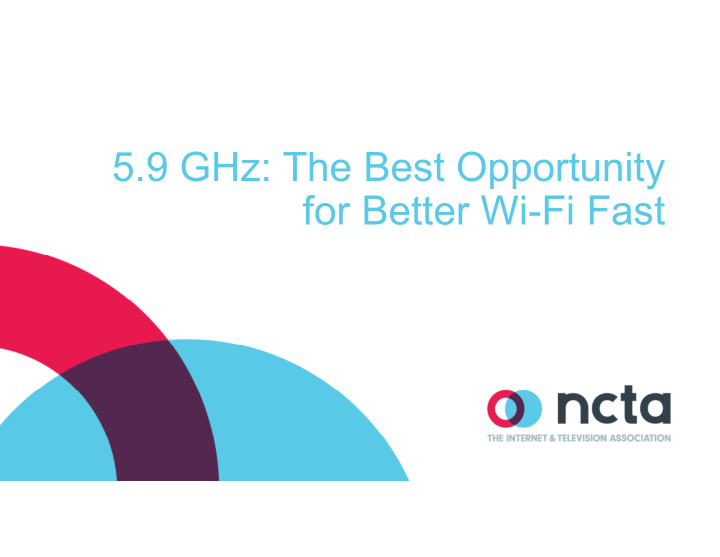



5.9 GHz: The Best Opportunity for Better Wi-Fi Fast
WI-FI IS HOW AMERICANS EXPERIENCE THE INTERNET • Since its debut in 1985, Wi-Fi has become a staple in American life. Wi-Fi networks, including the extensive networks deployed by cable operators, now carry the majority of U.S. wireless traffic. Cisco predicts that Wi-Fi will carry 52 percent of U.S. internet traffic by 2021, while cellular services will carry only 8.8 percent. • As of March 2018, the overwhelming majority of U.S. broadband households— 9 out of 10 —used Wi-Fi to connect to the internet. 2
3
WI-FI SPECTRUM NEEDS • American consumers and businesses need additional mid-band Wi-Fi spectrum as soon as possible, just to keep pace with today’s consumer and enterprise needs. • Wi-Fi Alliance study: the U.S. will need between 788 megahertz and 1.6 gigahertz of new mid-band unlicensed spectrum by 2025 to accommodate growing demand for Wi-Fi. • Qualcomm study: “regulators should plan for around 1280 MHz of unlicensed spectrum centered around the 5 GHz band for use by unlicensed technologies.” • Wi-Fi already powers hospitals operations, hundreds of billions of dollars in financial transactions daily, machine and IoT communications, and other crucial services— and is critical to the success of 5G. 4
5.9 GHZ IS THE RIGHT PLACE TO ADDRESS THE WI-FI SPECTRUM GAP • A combined 5.8/5.9 GHz band will let U.S. companies deploy next- generation 160-megahertz-wide gigabit Wi-Fi technologies. • This would be the first widely available contiguous 160-megahertz channel in the U.S. • Similar propagation to the 5.8 GHz means inexpensive devices will reach the market fast. 5
ENORMOUS ECONOMIC VALUE • Rand study: opening the band for Wi-Fi could add between $60 and $105 billion annually to our nation’s gross domestic product. • In addition to raising GDP, Wi-Fi could add up to $190 billion in consumer and economic surplus to the U.S. economy. 6
TODAY’S 5.9 GHZ BAND IS ALMOST COMPLETELY EMPTY • After 20 years, DSRC has not meaningfully deployed. V2V safety systems are not effective or reliable unless universally deployed in all U.S. cars and trucks. • There are only 70 pilot deployments in the entire United States. • Additionally, the DOT’s SPaT challenge, which sought to convince states and localities to deploy V2I, records just 216 intersections operational nationwide. 7
NCTA’S PROPOSAL • The best outcome is a proposal to relocate ITS to different spectrum and to re-designate the entire band for unlicensed use. • Emerging C-V2X services can and should use other spectrum—this is the perfect time to set up the bands correctly, when there are no C-V2X incumbents. • The FCC should not make the same mistake twice—granting the band to C-V2X would repeat the mistake of 1999 and tie up the band for at least another decade. 8
THE WAY FORWARD • The Commission should—without delay—issue an FNPRM that: • (1) Recognizes that past over-regulatory efforts to mandate a particular technology or to reserve the band for particular companies have failed; • (2) Finds that substantial changes in the 5 GHz spectrum environment, the market’s rejection of DSRC, and the pressing need for additional unlicensed spectrum support a proposal to designate all or a substantial portion of the 5.9 GHz band for unlicensed use; and • (3) Seeks comment on whether to allocate other, more suitable spectrum for automotive communications technologies. 9
Recommend
More recommend